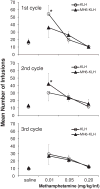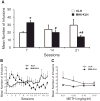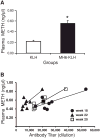Effects of active anti-methamphetamine vaccination on intravenous self-administration in rats
- PMID: 26118833
- PMCID: PMC4509945
- DOI: 10.1016/j.drugalcdep.2015.06.014
Effects of active anti-methamphetamine vaccination on intravenous self-administration in rats
Abstract
Background: d-Methamphetamine (METH) addiction is a serious public health concern for which successful treatment remains elusive. Immunopharmacotherapy has been shown to attenuate locomotor and thermoregulatory effects of METH. The current study investigated whether active vaccination against METH could alter intravenous METH self-administration in rats.
Methods: Male Sprague-Dawley rats (Experiment 1: N=24; Experiment 2: N=18) were vaccinated with either a control keyhole-limpet hemocyanin conjugate vaccine (KLH) or a candidate anti-METH vaccine (MH6-KLH) or. Effects of vaccination on the acquisition of METH self-administration under two dose conditions (0.05, 0.1mg/kg/inf) and post-acquisition dose-substitution (0, 0.01, 0.05, 0.20mg/kg/inf, Experiment 1; 0.01, 0.05, 0.10, 0.15mg/kg/inf, Experiment 2) during steady-state responding were investigated. Plasma METH concentrations were determined 30min after an acute challenge dose of 3.2mg/kg METH.
Results: Active vaccination inhibited the acquisition of METH self-administration under the 0.1mg/kg/inf dose condition, with 66% of the MH6-KLH-vaccinated rats compared to 100% of the controls reaching criteria, and produced transient and dose-dependent effects on self-administration during the maintenance phase. Under the 0.05mg/kg/inf dose condition, MH6-KLH-vaccinated rats initially self-administered more METH than controls, but then self-administration decreased across the acquisition phase relative to controls; a subsequent dose-response assessment confirmed that MH6-KLH-vaccinated rats failed to acquire METH self-administration. Finally, plasma METH concentrations were higher in MH6-KLH-vaccinated rats compared to controls after an acute METH challenge, and these were positively correlated with antibody titers.
Conclusions: These data demonstrate that active immunopharmacotherapy for METH attenuates the acquisition of METH self-administration.
Keywords: Active vaccination; Drug addiction; Immunopharmacotherapy; Methamphetamine; Self-administration.
Copyright © 2015 Elsevier Ireland Ltd. All rights reserved.
Conflict of interest statement
Figures





Similar articles
-
Effective active vaccination against methamphetamine in female rats.Drug Alcohol Depend. 2017 Jun 1;175:179-186. doi: 10.1016/j.drugalcdep.2017.03.005. Epub 2017 Apr 14. Drug Alcohol Depend. 2017. PMID: 28437722 Free PMC article.
-
A methamphetamine vaccine attenuates methamphetamine-induced disruptions in thermoregulation and activity in rats.Biol Psychiatry. 2013 Apr 15;73(8):721-8. doi: 10.1016/j.biopsych.2012.09.010. Epub 2012 Oct 23. Biol Psychiatry. 2013. PMID: 23098894 Free PMC article.
-
Vaccination protects rats from methamphetamine-induced impairment of behavioral responding for food.Vaccine. 2013 Sep 23;31(41):4596-602. doi: 10.1016/j.vaccine.2013.07.038. Epub 2013 Jul 29. Vaccine. 2013. PMID: 23906885 Free PMC article.
-
Vaccine development against methamphetamine drug addiction.Expert Rev Vaccines. 2020 Dec;19(12):1105-1114. doi: 10.1080/14760584.2020.1857738. Epub 2020 Dec 10. Expert Rev Vaccines. 2020. PMID: 33251859 Review.
-
Development of active and passive human vaccines to treat methamphetamine addiction.Hum Vaccin. 2009 Apr;5(4):206-13. doi: 10.4161/hv.5.4.7456. Epub 2009 Apr 20. Hum Vaccin. 2009. PMID: 19276653 Free PMC article. Review.
Cited by
-
Treatment of stimulant use disorder: A systematic review of reviews.PLoS One. 2020 Jun 18;15(6):e0234809. doi: 10.1371/journal.pone.0234809. eCollection 2020. PLoS One. 2020. PMID: 32555667 Free PMC article.
-
Effects of a methamphetamine vaccine, IXT-v100, on methamphetamine-related behaviors.Psychopharmacology (Berl). 2020 Mar;237(3):655-667. doi: 10.1007/s00213-019-05399-6. Epub 2019 Nov 22. Psychopharmacology (Berl). 2020. PMID: 31758209
-
Novel technologies in detection, treatment and prevention of substance use disorders.J Food Drug Anal. 2019 Jan;27(1):22-31. doi: 10.1016/j.jfda.2018.09.003. Epub 2018 Sep 28. J Food Drug Anal. 2019. PMID: 30648574 Free PMC article. Review.
-
Optimization of a methamphetamine conjugate vaccine for antibody production in mice.Int Immunopharmacol. 2016 Jun;35:137-141. doi: 10.1016/j.intimp.2016.03.028. Epub 2016 Apr 16. Int Immunopharmacol. 2016. PMID: 27039212 Free PMC article.
-
Gut and brain profiles that resemble pre-motor and early-stage Parkinson's disease in methamphetamine self-administering rats.Drug Alcohol Depend. 2021 Aug 1;225:108746. doi: 10.1016/j.drugalcdep.2021.108746. Epub 2021 May 20. Drug Alcohol Depend. 2021. PMID: 34098381 Free PMC article.
References
-
- Anthony JC, Warner LA, Kessler RC. Comparative epidemiology of dependence on tobacco, alcohol, controlled substances and inhalants: Basic findings from the national comorbidity survey. Exp Clin Pyschopharmacol. 1994;2:244–268.
Publication types
MeSH terms
Substances
Grants and funding
LinkOut - more resources
Full Text Sources
Other Literature Sources
Medical

